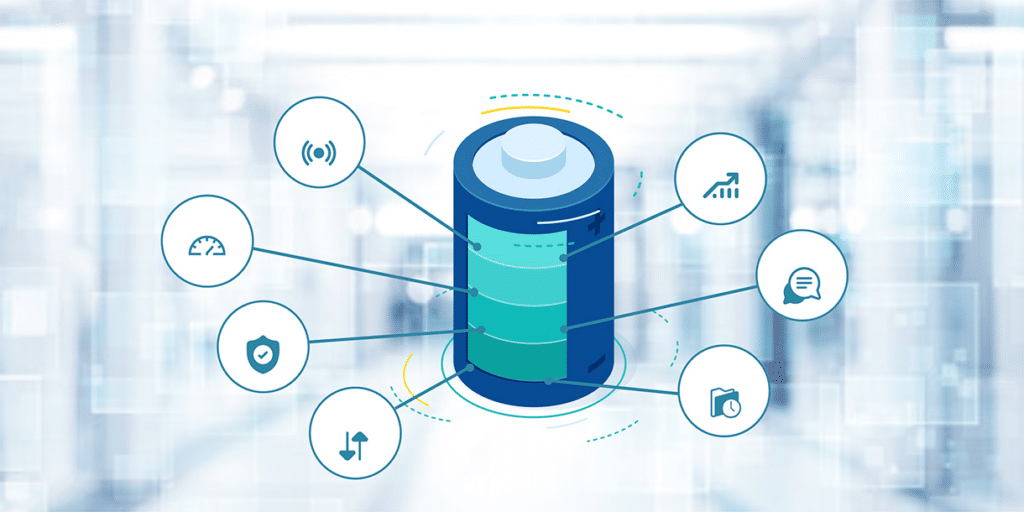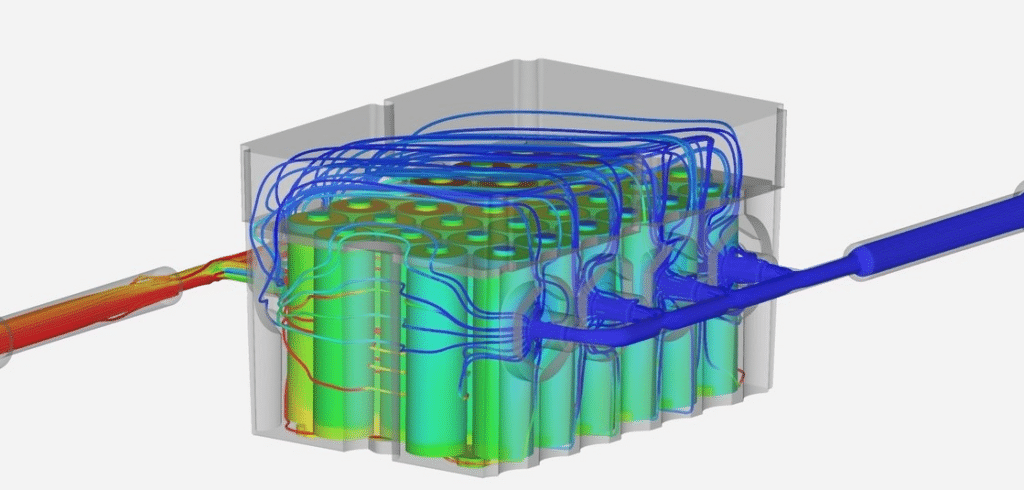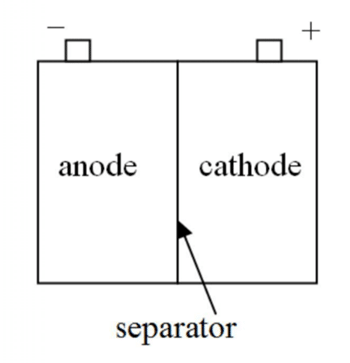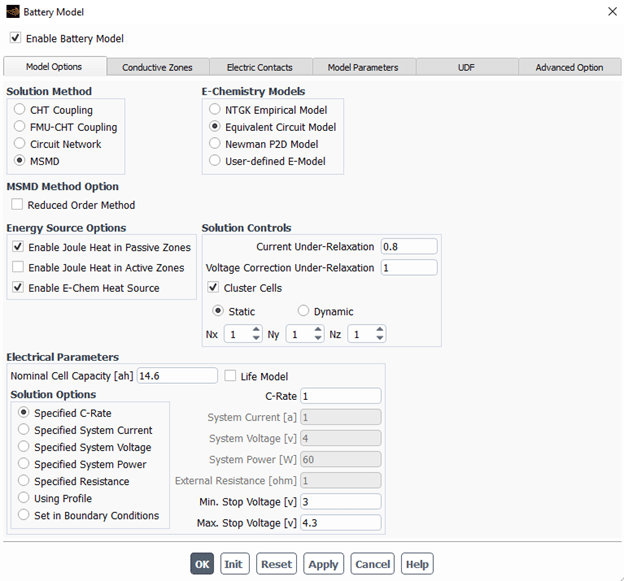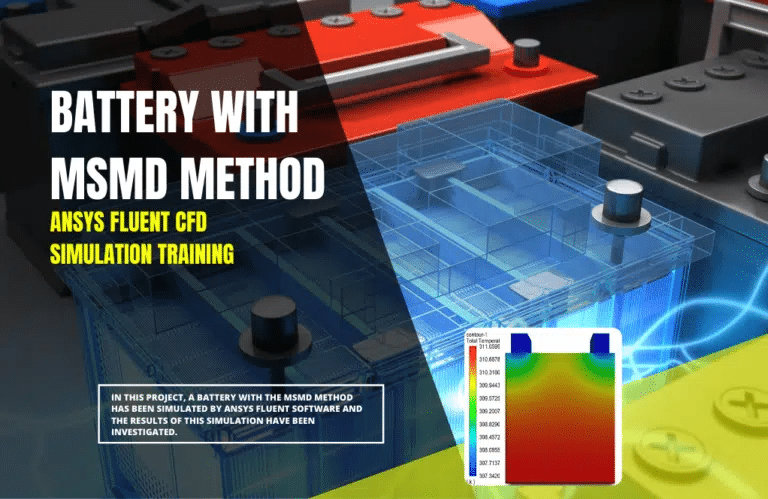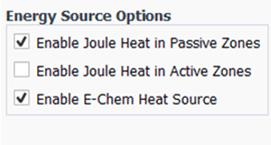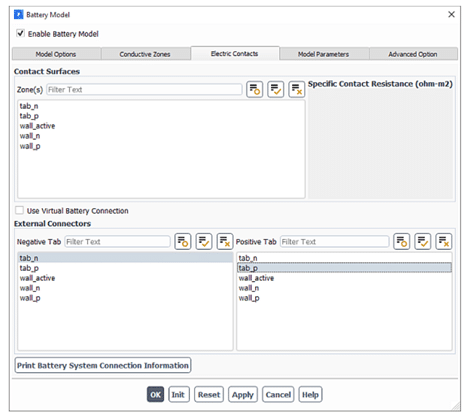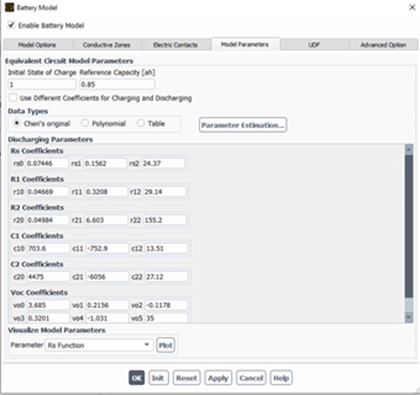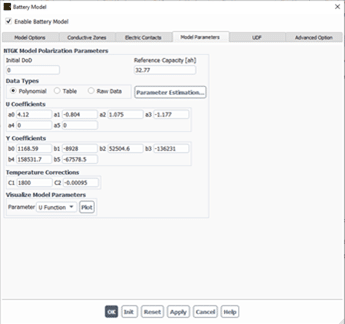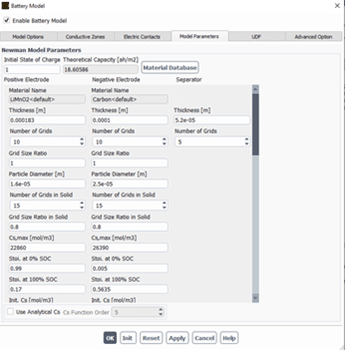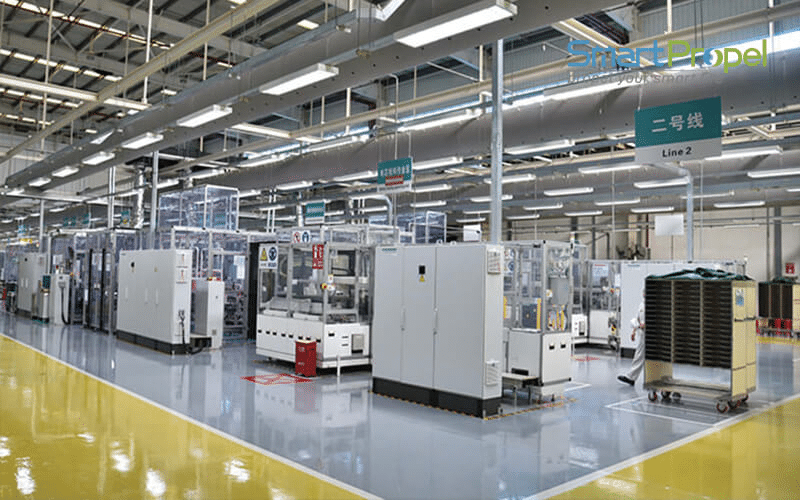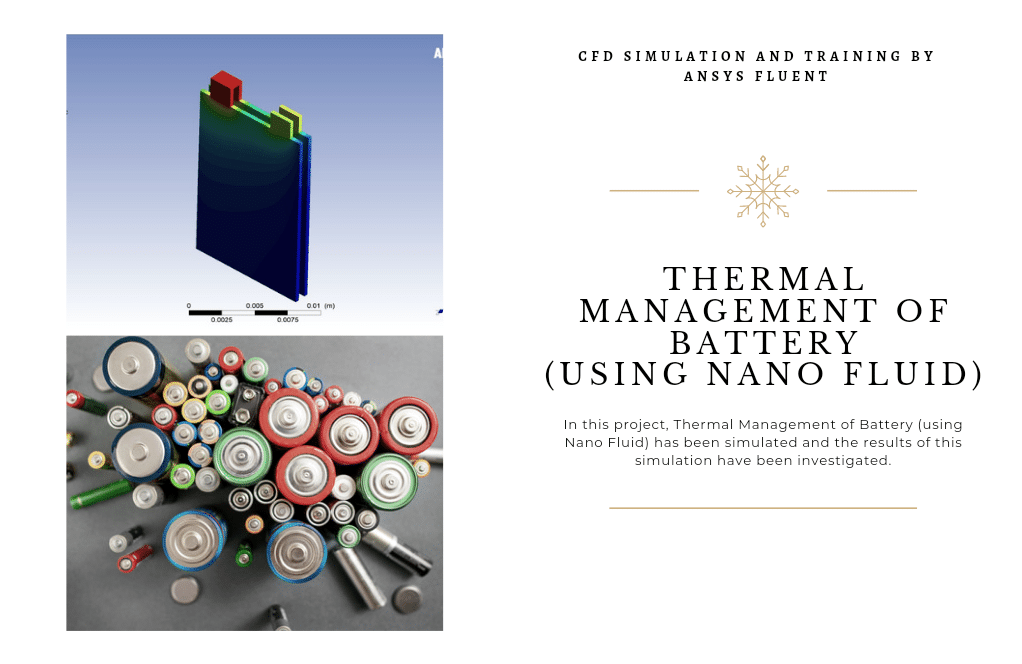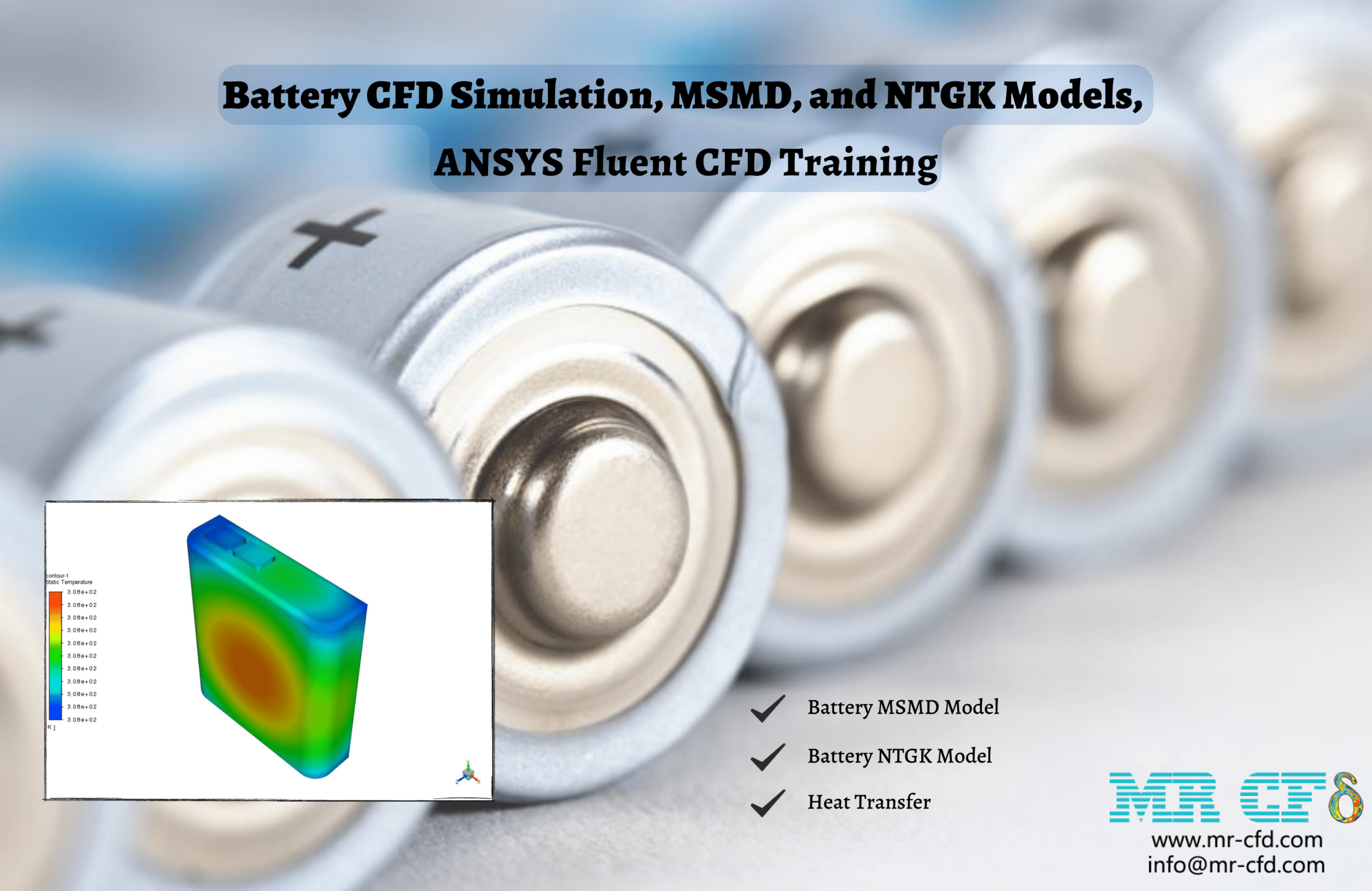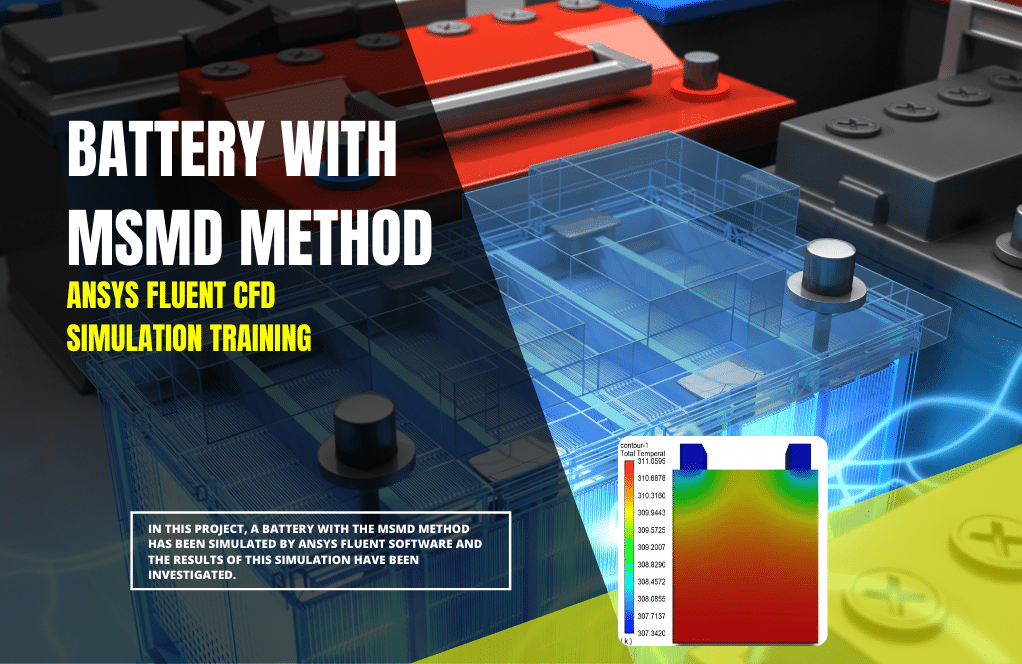Project Outsourcing
Outsource your project to the MR CFD simulation engineering team. Our experts are ready to carry out every CFD project in all related engineering fields. Our services include industrial and academic purposes, considering the ANSYS Fluent software's wide range of CFD simulations. By outsourcing your project, you can benefit from MR CFD's primary services, including Consultation, Training, and CFD Simulation. The project freelancing procedure is as follows:
An official contract will be set based on your project description and details.
As we start your project, you will have access to our Portal to track its progress.
You will receive the project's resource files after you confirm the final report.
Finally, you will receive a comprehensive training video and technical support.
What is a Battery?
A battery is a device that stores electrical energy as chemical energy and transforms it into electricity. It comprises one or more electrochemical cells, each with an anode, a cathode, and an electrolyte.
When a device is linked to a battery, a chemical reaction happens on the electrodes, resulting in a flow of electrical energy to the device.
Batteries are classified into two types:
Primary batteries
These are designed to be used once and then discarded. They are not intended to be recharged and reused with electricity. Examples are AA and AAA batteries, which are often found in a variety of gadgets.
Secondary batteries
These are rechargeable and can be used several times. Lithium-ion batteries, which are used in laptops, cellphones, and electric vehicles, are examples.
How can Battery CFD simulation be applied in Engineering and Industries?
Battery Computational Fluid Dynamics (CFD) simulation is important in engineering and industry, especially in designing and optimizing battery systems. Here are some examples of how it might be used:
Thermal Management
CFD models of battery systems can be used to anticipate and manage heat generation and dissipation. This is critical in electric vehicles and portable electronic devices, where battery overheating can degrade performance or possibly cause safety hazards.
Battery Design Optimization
Engineers can improve a battery’s design for increased efficiency, longevity, and safety by simulating its internal processes. This includes optimizing the electrode design, electrolyte composition, and cell architecture.
Predictive Analysis
Battery CFD simulations can forecast performance under various operating situations and usage patterns. This can forecast battery life, performance degradation over time, and the influence of various stress factors.
Safety Analysis
Battery CFD models can aid in identifying and minimizing battery safety hazards, such as thermal runaway, a common cause of battery fires.
Manufacturing Process Optimization
Battery CFD simulations can also optimize manufacturing processes such as coating, drying, and calendaring to ensure consistent battery quality and performance. Finally, Battery CFD modeling is valuable for engineers and enterprises dealing with battery systems. It provides important insights into the complicated internal processes of batteries and aids in optimizing their design, performance, safety, and manufacturing processes.
MR CFD services in the Battery Simulation for Engineering and Industries
With several years of experience simulating various problems in various CFD fields using ANSYS Fluent software, the MR CFD team is ready to offer extensive modeling, meshing, and simulation services. Simulation Services for Battery CFD simulations are categorized as follows:
- Simulation and analysis of Batteries with different methods such as MSMD, NTGK, etc.
- Thermal CFD simulation of Batteries in case of nanofluids.
- Cooling of Batteries with the existence of PCM material.
- …
For engineering and industries, MR CFD services might be quite valuable in the field of battery simulation. Here’s a quick rundown of how it can help:
Battery Simulation using MR CFD Services
MR CFD is a full-service simulation solution provider in battery technology. It provides precise and dependable findings using modern Computational Fluid Dynamics (CFD) technologies. Here’s how you can use it:
– Battery Design Optimization: Engineers can use simulation to test different design parameters and optimize battery design for optimal efficiency and longevity. This includes adjusting the temperature management system of the battery, which is critical for its performance and safety.
– Performance Analysis: MR CFD can simulate the functioning of the battery under various conditions. This enables engineers to comprehend the battery’s behavior and performance in various settings, which can aid in improving its design and operation.
– Safety Analysis: Batteries, particularly lithium-ion batteries, can be dangerous owing to thermal runaway. These scenarios can be simulated using MR CFD to assist engineers in designing safer batteries.
– Lifetime Prediction: By simulating the operation of the battery over time, MR CFD can help predict its lifespan. This is critical for scheduling maintenance and replacements.
– Cost-effective: Because all testing is done online, it can save much money compared to physical testing.
Here’s a simple example of how MR CFD can be used for battery simulation:
– Configure the simulation settings (such as temperature and charge/discharge rates).
– Simulate to evaluate the performance and safety of the battery.
– Apply the findings to improve the battery’s design.
Remember that MR CFD is a powerful company that can provide useful insights into battery technology. However, you must understand CFD and battery technology to utilize it successfully.
We hope this helps you understand how MR CFD services can be used in battery simulation for engineering and industry.
How to Model Battery inside ANSYS Fluent
There are multiple processes for modeling a battery in ANSYS Fluent. Here’s a starting point:
1. Creation of Geometry
To begin, you must build the geometry of the battery that you wish to simulate. You can construct the geometry in any CAD software and then import it into ANSYS.
2. Combination
After importing the geometry, the meshing process begins. To generate the mesh, utilize the ANSYS meshing tool. Ensure the mesh is fine enough to capture the battery’s details.
3. Setup
You must now configure the problem in ANSYS Fluent. This comprises defining the material qualities, boundary constraints, and starting points.
4. Solution
You can now solve the problem after establishing it. Check the convergence criteria carefully.
5. Post Production
After you have completed the solution, you can analyze the results using ANSYS Fluent’s post-processing tools.
6. Model of Battery
The Battery Model in ANSYS Fluent can be used to simulate battery performance. The ANSYS Fluent Battery Model allows you to model a battery’s charge and discharge processes.
Go to ‘Models > Energy Source > Battery’ to open the Battery Model. The battery’s parameters, such as open circuit voltage, internal resistance, and capacity, can then be entered.
You can also provide the battery’s State of Charge (SOC) at the start of the experiment. The SOC measures the amount of energy remaining in the battery. Remember that the precision of your findings is determined by the accuracy of your inputs and the quality of your mesh. Always verify your work for faults twice. The ANSYS Fluent battery model is an add-on module with the standard ANSYS Fluent censed software. This module is accessible from the console with defined models addon-module.
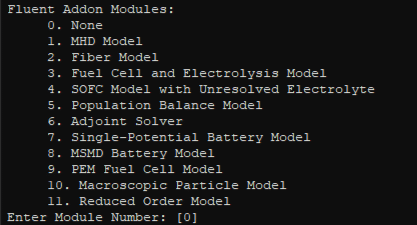
Given the important role of a battery in electric and hybrid electric vehicles, several models have been proposed to simulate the transient behavior of the rechargeable battery. These models vary in complexity from a zero-dimension resistor-capacitor to a multi-dimension potential current distribution. The software’s general model is the MSMD (Multiscale Multiphysics Battery) model.
The computational domain includes only the anode and cathode electrodes and their current collectors. The separator layer is modeled as an infinitely thin interface between the two electrodes across which there is a potential-jump due to loss. The battery geometry consists of a cell and positive and negative tabs. The cell consists of an active zone, and the tabs are a passive zone. Electrochemical reactions only accrue in active zones that the potential field solves in active and passive zones.
 Battery Model Tab
Battery Model Tab
The battery model includes different tabs. The first tab is in model options. In the solution method section, four methods are available to select.
 1. CHT coupling
1. CHT coupling
pure conjugate heat transfer method to simulate steady-state or transient heat production is known or obtained by other methods. The purpose of this simulation is to predict the temperature field of the module or pact. This is the easiest method in the electric thermocouple.
2. MSMD
Multiscale Multiphysics Battery
The current study employs ANSYS Fluent software to simulate a hypothetical twin battery. The battery has a nominal voltage of 24 amps and a C-RATE rating 10. Specific thermal conductivity and electrical conductivity are defined for the material.
Following the simulation, the temperature distribution and potential distribution contours are derived. The greater the battery’s C RATE, the faster it will charge and discharge, and the temperature generated in the battery will rise.
3. FMU-CHT coupling
functional mock-up unit coupled is suitable for users who have used electrochemical models of various ECMs in the third-party component. It is used in ANSYS Fluent, and co-simulation can be achieved by importing FMU into Fluent.
4. Circuit Network
the user wants to use the electrochemical model to calculate the heat source of the battery, such as the ECM model. In this type of coupled calculation, the heat source of the cell is uniformly distributed and can be obtained from the sub-electrochemical model. And it’s generally transient.
E-Chemistry models

The NTGK model is set up by a curve fitting the experimental data. This model is used to obtain the total heat from an electrochemical reaction and predict the temperature distribution of the battery cell.
Newman p2D model The so-called pseudo-two-dimensional (P2D) model developed by the Newman group is probably the most widely used lithium-ion battery model of this type. It comprises a one-dimensional macro-scale model describing the evolution of lithium concentration and electric potential in the electrolyte across the anode, separator, cathode, and micro-scale models for the electrodes.
The pseudo-second dimension arises from these coupled one-dimensional micro-scale models describing the solid-phase diffusion of lithium in the porous active material of the electrodes. These micro-scale models solve the diffusion of lithium occurring in a spherical particle at each local position of the macro-scale porous electrode model.
Energy source options
 Enable joule heat passive/active source
Enable joule heat passive/active source
to include the joule heating source in their thermal energy equation
Enable E-chem heat source
to include the heat source due to electrochemistry in the thermal energy equation.
Solution controls
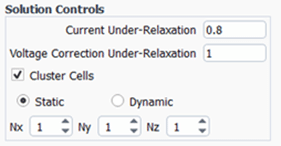
Note: this tab is available only with the MSMD method.
Electrical Parameters

Specified C-Rate
The C-rate is the unit battery experts use to measure the speed at which a battery is fully charged or discharged. For example, charging at a C-rate of 1C means the battery is charged from 0-100% in one hour. A C-rate higher than 1C means a faster charge. For example, a 3C rate is three times faster, so a full charge in 20 minutes. Likewise, a lower C-rate means a slower charge: C/5 (or 0.2C) would be five times slower than 1C, amounting to a five-hour charge. You can set the value for the Discharge C-rate (the hourly rate at which a battery is discharged). In this case, the total current at the cathode tabs is fixed as the product of C-rate and nominal capacity, while the electrical potential is anchored at zero on the anode tabs.
Specified system current
you can set a value for the total current (applied to the anode tabs). In this case, the electrical potential is set to zero at the anode tabs.
Specified system voltage
You can set a value for the system voltage ( applied to the cathode tab; the anode tab has a voltage of 0v).
Specified system resistance
You can set a value for system resistance ( applied to the anode tab)
Set in the boundary condition
You can set the uds boundary condition directly.
Conductive Zone tab
For this single-cell case, there are no busbar zones. Electrochemical reactions occur only in the active zone. Battery tabs are usually modeled as passive zones, where the potential field is also solved.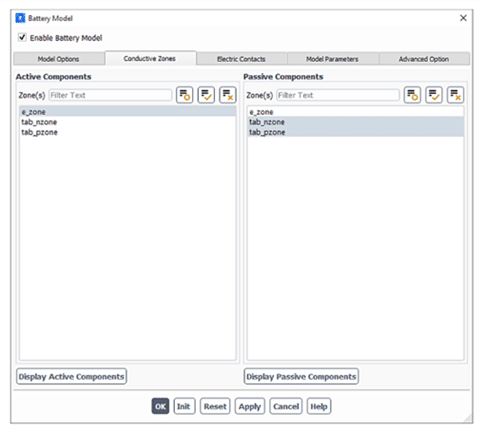
Under the Electric Contacts tab, configure the contact surface and external connector settings. The corresponding current or voltage boundary condition will automatically be applied to those boundaries. Under the Electric Contacts tab, you can define extra contact resistance for each zone.
 Model Parameters tab
Model Parameters tab
 MSMD with ECM parameters
MSMD with ECM parameters
For the Electric Circuit Model, you can specify the function coefficients for the resistors’ resistances, capacitors’ capacitances, and the open circuit voltage (Voc) to be used. To specify the ECM model functions in the polynomial form, select Using polynomials and enter parameters. In addition, you can turn on the Using different coefficients for charging and discharging option and specify the coefficients for Charging parameters.
You can also set values for the Initial State of Charge and Reference Capacity. The default value of 1 for the Initial State of Charge indicates the fully charged state of the battery cell.
The coefficient values for the Electric Circuit Model are battery-specific and need to be specified before conducting a simulation. The default values are taken from Chen. If you model a battery of a different design, you should specify a different set of parameters.
 MSMD with NTGK parameters
MSMD with NTGK parameters
For the NTGK model, you can specify the U coefficients, Y coefficient, and temperature correction. The coefficient values for the NTGK Model Polarization Parameters are based on battery cell polarization test curves. Obtaining coefficient values (other than the default values) can depend on your battery configuration and material properties. The default values are taken from Kim’s paper. If you model a battery with a different design, you must provide a different set of parameters.
 MSMD with P2D parameters
MSMD with P2D parameters
Complete and comprehensive explanations of all inputs are available in the software documentation.
Battery CFD Simulation, MSMD, and NTGK Models

Given the importance of batteries in electric and hybrid electric cars, numerous models for simulating the transient behavior of rechargeable batteries have been presented. The complexity of these models ranges from a zero-dimension resistor capacitor to a multi-dimension potential current distribution. MSMD (Multiscale Multiphysics Battery) Model is the general model offered in the software.
The NTGK model is created by fitting a curve to the experimental data. This model is also used to calculate the total heat produced by an electrochemical process and to forecast the temperature distribution of a battery cell.
According to the simulation results, the temperature reaches equilibrium at 308 degrees, and the middle of the battery body is warmer than other regions. The battery charges in about 25 minutes and provides 3.6 volts.
Battery MR CFD Projects
Here are some project suggestions:
Battery Thermal Management System develop
CFD can be used to develop and optimize a battery thermal management system. This will entail building a 3D model of the battery and its cooling system and then performing simulations to understand how heat is distributed and dissipated.
Thermal Management of Battery Using Nano Fluid
The current challenge uses Ansys Fluent software to model the Thermal Management of a Battery Using Nano Fluid (Two-Phase). This simulation is associated with the Dual-Potential MSMD (multiscale multidomain) battery model. In general, a battery can store electrical energy in the form of chemical energy. When the battery’s current is requested, the chemical energy is turned into electrical energy, and when the battery is charged, the electrical energy is converted back into chemical energy. Heat can also be created from various causes, such as internal joule heating losses and local electrode overpotentials, the entropy of the cell process, the heat of mixing, and side reactions.
A modular, efficient battery simulation model (MSMD model) was previously proposed to aid in the scale-up of Li-ion material and electrode designs to entire cell and pack designs, capturing electrochemical interplay with 3-D electronic current pathways and temperature response. The scalable and adaptable design efficiently connects the physics of battery charge/discharge operations, heat control, safety, and reliability.
The current simulation uses the Mixture multiphase model, and the influence of nanofluid flow on battery heat transfer enhancement is explored. This research examines the usefulness of phase change materials in battery cooling. The nanofluid material is water as the base fluid and aluminum as nanoparticles, with a velocity of 0.1 m/s at the intake face. Nanoparticles have a volume fraction of 0.05.
E-Chemistry is using the GK empirical model. Electrical characteristics are specified C-rate of 0.5 and numerical cell capacity of 14.6.
After the solution process, we acquired two-dimensional and three-dimensional pressure and temperature contours, respectively. This chart was presented in 500 seconds. The results reveal that adding a Nanofluid flow to the battery body cools and slows the rate of temperature rise.
Battery Cooling (Thermal Management) by PCM
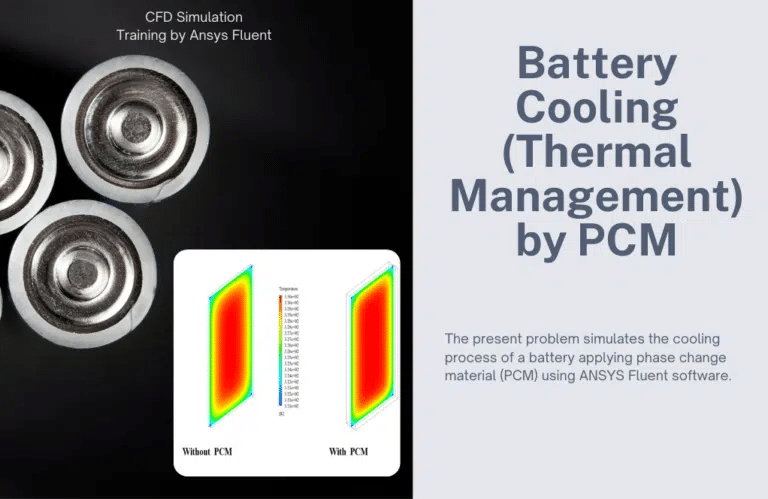
The current simulation is divided into two stages: the first stage models only one lithium battery, while the second stage uses two layers of phase change material on both sides of the battery. This research examines the usefulness of phase change materials in battery cooling.
In both simulation processes, we receive two-dimensional and three-dimensional temperature contours at the end of the solution procedure. At the end of the simulation, we compare the temperature contours in both stages.
In addition, for the two states with and without phase change material, we obtain a diagram showing the average temperature changes of the battery in terms of time. This graphic will be presented in one hour. The results reveal that covering the battery body with a phase transition material cools the battery and slows the rate of temperature development.
In the second stage of the simulation, two-dimensional and three-dimensional contours relating to the volume percent of liquid from the phase change material are obtained to demonstrate its effect on heat transfer with the battery body.
Battery Pack Design
You can use CFD to assess how the heat generated by the batteries affects the overall performance of a battery pack for an electric vehicle or another application.
Battery Material Analysis
CFD can be used to study the performance of various battery materials. This could include replicating the passage of ions through the material, as well as heat generation and dissipation.
Battery Degradation Research
Batteries degrade over time due to various factors such as temperature, charge/discharge cycles, etc. CFD can be used to investigate how these factors affect battery degradation.
Remember that these tasks necessitate a solid understanding of battery technology and CFD. You’ll also need access to the necessary software to execute the simulations.
Battery Industrial Companies
Here are some of the most prominent industrial enterprises specializing in battery technology:
Tesla Motors Inc.
Best known for its electric vehicles, Tesla also manufactures clean energy generation and storage solutions. They are most known for lithium-ion batteries and the Gigafactory, which mass-produces these batteries.
Panasonic
Panasonic is A prominent lithium-ion battery supplier and a Gigafactory partner for Tesla.
BYD Co Ltd
This Chinese corporation is one of the world’s major manufacturers of rechargeable batteries.
LG Chem
LG Chem is a leading supplier of lithium-ion batteries for electric vehicles and energy storage systems based in South Korea.
Samsung SDI
Samsung SDI is another South Korean business noted for its lithium-ion batteries used in electric vehicles and energy storage systems.
CATL stands for Contemporary Amperex Technology Co., Limited.
This company is a market leader in developing and producing lithium-ion batteries.
EnerSys
EnerSys, a global pioneer in stored energy solutions, offers various batteries for various sectors.
Exide Technologies
Exide Technologies is well-known for its lead-acid batteries and services in the transportation and industrial sectors.
Duracell Inc
It is a well-known consumer battery firm that also manufactures industrial batteries.
Energizer Holdings, Inc.
Energizer offers a variety of industrial batteries in addition to consumer batteries.
MR CFD Industrial Experience in the Battery Field
Some examples of Battery industrial projects recently simulated and analyzed by MR CFD in cooperation with related companies are visible on the MR CFD website.
You may find the Learning Products in the Battery CFD simulation category in the Training Shop. You can also benefit from the Battery Training Package, which is appropriate for Beginners, Intermediate, and Advanced users of ANSYS Fluent. Also, MR CFD is presenting the most comprehensive Battery Training Course for all ANSYS Fluent users from Beginner to Experts.
Our services are not limited to the mentioned subjects. The MR CFD is ready to undertake different and challenging projects in the Battery modeling field ordered by our customers. We even carry out CFD simulations for any abstract or concept Design you have to turn them into reality and even help you reach the best strategy for what you may have imagined. You can benefit from MR CFD expert Consultation for free and then Outsource your Industrial and Academic CFD project to be simulated and trained.
By outsourcing your Project to MR CFD as a CFD simulation consultant, you will not only receive the related Project’s resource files (Geometry, Mesh, Case, and Data, etc.), but you will also be provided with an extensive tutorial video demonstrating how you can create the geometry, mesh, and define the needed settings (preprocessing, processing, and postprocessing) in the ANSYS Fluent software. Additionally, post-technical support is available to clarify issues and ambiguities.
Portfolios
-
Sale
Battery CFD Simulation Training Package, 4 Projects by ANSYS Fluent
Original price was: $730.00.$122.00Current price is: $122.00. Student Discount
